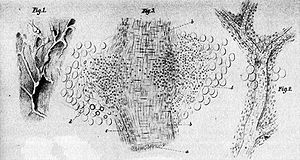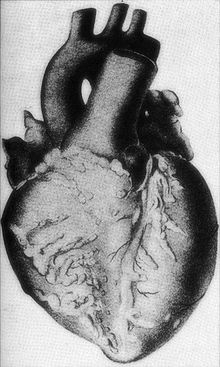- Polyarteritis nodosa
-
Polyarteritis nodosa Classification and external resources ICD-10 M30.0 ICD-9 446.0 DiseasesDB 10220 MedlinePlus 001438 MeSH D010488 Polyarteritis nodosa (also known as "Panarteritis nodosa,"[1] and "Periarteritis nodosa"[1]) is a vasculitis of medium & small-sized arteries, which become swollen and damaged from attack by rogue immune cells. Polyarteritis nodosa is also called Kussmaul disease or Kussmaul-Maier disease.[2] Infantile polyarteritis nodosa is a type of PAN restricted to infants.[3]
Contents
Causes and risk factors
Polyarteritis nodosa is a disease of unknown cause that affects arteries, the blood vessels that carry blood from the heart to organs and tissues. A minority of people (about 30%) diagnosed have an active Hepatitis B infection, and men are also twice as likely to get the disease as women.
Incidence
The condition affects adults more frequently than children and males more frequently than females. Most cases occur between the ages of 30 and 49. It damages the tissues supplied by the affected arteries because they don't receive enough oxygen and nourishment without a proper blood supply.
Polyarteritis nodosa is more common in people with hepatitis B infection.[4]
Symptoms
In this disease, symptoms result from ischaemic damage to affected organs, often the skin, heart, kidneys, and nervous system.
Generalised symptoms include fever, fatigue, weakness, loss of appetite, and weight loss. Muscle and joint aches are common. The skin may show rashes, swelling, ulcers, and lumps.[citation needed]
Nerve involvement may cause sensory changes with numbness, pain, burning, and weakness. Central nervous system involvement may cause strokes or seizures. Kidney involvement can produce varying degrees of renal failure.[citation needed]
Involvement of the arteries of the heart may cause a heart attack, heart failure, and inflammation of the sac around the heart (pericarditis).
- Fatigue
- Weakness
- Fever
- Abdominal pain
- Decreased appetite
- Unintentional weight loss
- Muscle aches
- Joint aches[citation needed]
Diagnosis
 Microscopic findings in polyarteritis nodosa: nodular thickened and branched arteries from small bowel mucosa (Fig. 1). Flexor digitorum superficialis artery with early diffuse nuclear proliferation (X155; Fig. 2). Nodular thickened and aneurysmal expanded artery: (a) tunica intima, (b) tunica media, (c) tunica adventitia, (d) newly formed connective tissue and fat (Fig. 3; X155)
Microscopic findings in polyarteritis nodosa: nodular thickened and branched arteries from small bowel mucosa (Fig. 1). Flexor digitorum superficialis artery with early diffuse nuclear proliferation (X155; Fig. 2). Nodular thickened and aneurysmal expanded artery: (a) tunica intima, (b) tunica media, (c) tunica adventitia, (d) newly formed connective tissue and fat (Fig. 3; X155)
There are no specific lab tests for diagnosing polyarteritis nodosa. Diagnosis is generally based upon the physical examination and a few laboratory studies that help to confirm the diagnosis:
-
- CBC (may demonstrate an elevated white blood count)
- ESR (elevated)
- Perinuclear pattern of antineutrophil cytoplasmic antibodies (p-ANCA) - not associated with "classic" polyarteritis nodosa, but is present in a form of the disease affecting smaller blood vessels, known as microscopic polyangiitis or leukocytoclastic angiitis.
- Tissue biopsy (reveals inflammation in small arteries, called arteritis)
- Elevated C-reactive protein
A patient is said to have polyarteritis nodosa if he or she has 3 of the 10 following signs known as the 1990 ACR (American College of Rheumatology)[5] criteria:
-
- Weight loss greater than/equal to 4.5 kg.
- Livedo reticularis (a mottled purplish skin discoloration over the extremities or torso).
- Testicular pain or tenderness. (occasionally, a site biopsied for diagnosis).
- Muscle pain, weakness, or leg tenderness.
- Nerve disease (either single or multiple).
- Diastolic blood pressure greater than 90mmHg (high blood pressure).
- Elevated kidney blood tests (BUN greater than 40 mg/dl or creatinine greater than 1.5 mg/dl).
- Hepatitis B virus tests positive (for surface antigen or antibody).
- Arteriogram (angiogram) showing the arteries that are dilated (aneurysms) or constricted by the blood vessel inflammation.
- Biopsy of tissue showing the arteritis (typically inflamed arteries). [6] Sural nerve is a frequent location for the biopsy.
It should be underlined that the 1990 ACR criteria were designed for classification purposes only. Nevertheless their good discriminatory performances, indicated by the initial ACR analysis, suggested their potential usefulness for diagnostic purposes also. Subsequent studies did not confirm their diagnostic utility, demonstrating a significant dependence of their discriminant abilities on the prevalence of the various vasculitides in the analyzed populations. Recently an original study, combining the analysis of more than 100 items used to describe patients characteristics in a large sample of vasculitides with a computer simulation technique designed to test the potential diagnostic utility of the various criteria, proposed a set of eight positively or negatively PAN discriminating items to be used a screening tool for PAN diagnosis in patients suspected of systemic vasculitis.[7]
Treatment and Prognosis
Treatment involves medications to suppress the immune system, including prednisone and cyclophosphamide. Therapy results in remissions or cures in 90% of cases. Untreated, the disease is fatal in most cases. The most serious associated conditions generally involve the kidneys and gastrointestinal tract. A fatal course usually involves gastrointestinal hemorrhage, infection, myocardial infarction and/or renal failure.[8]
In case of remission, approximately 60% experience relapse within 5 years.[9] In cases caused by hepatitis B virus, however, recurrence rate is only approximately 6%.[10]
Complications
- Stroke[citation needed]
- Kidney failure[citation needed]
- Heart attack[citation needed]
- Intestinal necrosis and perforation[citation needed]
Prevention
This disease cannot be currently prevented, but early treatment can prevent some damage and symptoms.[citation needed]
See also
References
- ^ a b Rapini, Ronald P.; Bolognia, Jean L.; Jorizzo, Joseph L. (2007). Dermatology: 2-Volume Set. St. Louis: Mosby. ISBN 1-4160-2999-0.
- ^ synd/764 at Who Named It?
- ^ Person, A, Donald (2006-06-15). "Infantile Polyarteritis Nodosa". eMedicine. WebMD. http://emedicine.medscape.com/article/1006838-overview. Retrieved 24 December 2009.
- ^ Erhardt A, Sagir A, Guillevin L, Neuen-Jacob E, Häussinger D (October 2000). "Successful treatment of hepatitis B virus associated polyarteritis nodosa with a combination of prednisolone, alpha-interferon and lamivudine". J. Hepatol. 33 (4): 677–83. doi:10.1034/j.1600-0641.2000.033004677.x. PMID 11059878. http://linkinghub.elsevier.com/retrieve/pii/S0168-8278(00)80025-2.
- ^ American College of Rheumatology
- ^ Shiel, Jr., William C, http://www.medicinenet.com/polyarteritis_nodosa/article.htm
- ^ Henegar C, Pagnoux C, Puéchal X, Zucker JD, Bar-Hen A, Le Guern V, Saba M, Bagnéres D, Meyer O, Guillevin L (2008). A paradigm of diagnostic criteria for polyarteritis nodosa : analysis of a series of 949 vasculitides. Arthritis & Rheumatism 2008 Apr 25;58(5):1528-1538. http://dx.doi.org/10.1002/art.23470
- ^ AJ Giannini,HR Black. Psychiatric,Psychogenic and Somatopsychic Disorders Handbook. Garden City, NY. Medical Examination Publishing,1978. Pp.219-220. ISBN 0-87488-596-5
- ^ Selga, D.; Mohammad, A.; Sturfelt, G.; Segelmark, M. (2006). "Polyarteritis nodosa when applying the Chapel Hill nomenclature--a descriptive study on ten patients". Rheumatology 45 (10): 1276–1281. doi:10.1093/rheumatology/kel091. PMID 16595516.[1], Entry in Polyarteritis Nodosa Follow-up article
- ^ Guillevin, L.; Lhote, F.; Cohen, P.; Sauvaget, F.; Jarrousse, B.; Lortholary, O.; Noël, L.; Trépo, C. (1995). "Polyarteritis nodosa related to hepatitis B virus. A prospective study with long-term observation of 41 patients". Medicine 74 (5): 238–253. doi:10.1097/00005792-199509000-00002. PMID 7565065. [2], Entry in Polyarteritis Nodosa Follow-up article
External links
Vasculitis/arteritis: systemic vasculitis (M30–M31, 446) Large vessel Medium vessel Small vessel Pauci-immuneUngroupedAcute hemorrhagic edema of infancy · Bullous small vessel vasculitis · Cutaneous small-vessel vasculitisOther Categories:- Diseases involving the fasciae
- Rheumatology
- Vascular-related cutaneous conditions
- Systemic connective tissue disorders
Wikimedia Foundation. 2010.

